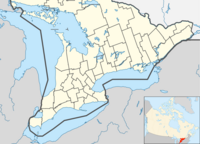Addison, Ontario
| Elizabethtown-Kitley | |
|---|---|
| Township (lower-tier) | |
| Township of Elizabethtown-Kitley | |

Township office in New Dublin
|
|
| Coordinates: 44°42′N 75°53′W / 44.700°N 75.883°WCoordinates: 44°42′N 75°53′W / 44.700°N 75.883°W | |
| Country |
|
| Province |
|
| County | Leeds and Grenville |
| Government | |
| • Mayor | Jim Pickard |
| • Federal riding | Leeds—Grenville |
| • Prov. riding | Leeds—Grenville |
| Area | |
| • Land | 557.80 km2 (215.37 sq mi) |
| Population (2011) | |
| • Total | 9,724 |
| • Density | 17.4/km2 (45/sq mi) |
| Time zone | EST (UTC-5) |
| • Summer (DST) | EDT (UTC-4) |
| Postal Code | K6T |
| Area code(s) | 613 |
| Website | www.elizabethtown-kitley.on.ca |
Elizabethtown-Kitley is a township in eastern Ontario, Canada, in the United Counties of Leeds and Grenville. Its southern border lies along the St. Lawrence River and it extends north into many rural hamlets and villages. The township was created on January 1, 2001 by the amalgamation of the former Township of Elizabethtown and Township of Kitley.
The township comprises the communities of Addison, Bellamys, Bellamys Mill, Bethel, Blanchard's Hill, Butternut Bay, Crystal, Eloida, Fairfield, Fairfield East, Fernbank, Forthton, Frankville, Glen Buell, Greenbush, Hallecks, Hawkes, Hillcrest, Jasper, Jellyby, Judgeville, Lehighs Corners, Lillies, Lyn, Manhard, Motts Mills, Newbliss, New Dublin, Redan, Rocksprings, Row's Corners, Seeley, Spring Valley, Tincap, Toledo and Woodridge. The township administrative offices are located in New Dublin.
During the time of its settlement in the late 1700s, Bellamys Mill would have been situated among thick forest with small spring-fed streams whereas presently, the site now sits on a lake called Bellamy Lake. The lake was the result of damming, which created a large swamp. During the late eighteenth century the land was ideal for building a settlement, and in 1798, a man named John Livingston established a gristmill here which a community later surrounded. The mill was likely made of stone, as sawn lumber would have been hard to obtain in the settlement that early, however there is no confirmed account of the building materials used. There is no trace of the mill today; only records from the township and other histories as well as the remnants of an old stone bridge indicate its existence. The building was destroyed by fire. In 1822, a sawmill was established nearby this mill which ran until the 1900s.
Bellamys Mill was its own common school section, known as school section #10. The school, first built in 1836, was named S.S. #10 Mahon’s School. The first log schoolhouse burned down and was rebuilt in the 1850s across the road. The school ran successfully until the 1910s when it was periodically closed and reopened until its permanent closure in the 1940s. At the time of its closure it was converted into a private residence. Additionally at Bellamys Mill was a Roman Catholic separate school, known as R.C. #10.
Around 1830, land owned by the Livingston family was being used as a community burial ground. Although commonly called Dayton’s Cemetery, the burying ground’s name upon establishment was Livingston’s Cemetery after the family who started it and were first buried there. The first burial was a member of the Livingston family, buried there in 1803 before it became a community cemetery. The cemetery is slightly unique, as instead of tombstones, most of the graves are marked by primitive field stone markers. There are around one hundred stones in the cemetery, however it is estimated there are around two hundred individuals actually buried here. Presently, the cemetery sits on the northern tip of Bellamys Lake and is maintained, but not open to burials.
...
Wikipedia

